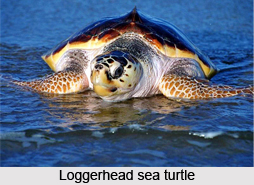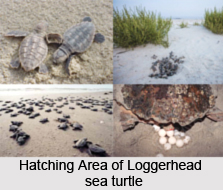 Loggerhead Sea Turtle is an Indian marine species that bears a scientific name "Caretta caretta" or loggerhead.
Loggerhead Sea Turtle is an Indian marine species that bears a scientific name "Caretta caretta" or loggerhead.
Category of Loggerhead Sea Turtle
Loggerhead Sea Turtle is an oceanic turtle distributed throughout the world. It is a marine reptile, belonging to the family of Cheloniidae.
Measurement of Loggerhead Sea Turtle
Loggerhead Sea Turtle measures around 90 cm (35 in) long when fully grown, although larger specimens of up to 280 cm (110 in) have been discovered. The adult loggerhead sea turtle weighs approximately 135 kg (298 lb), with the largest specimens weighing in at more than 450 kg (1,000 lb). The skin ranges from yellow to brown in colour, and the shell is typically reddish-brown. No external differences in gender are seen until the turtle becomes an adult, the most obvious difference being the adult males have thicker tails and shorter plastrons than the females.
Concentration of Loggerhead Sea Turtle
Loggerhead Sea Turtle is found in the Atlantic Ocean, Pacific Ocean, Arabian Sea and Indian Ocean, as well as the Mediterranean Sea.
Behaviour of Loggerhead Sea Turtle
Loggerhead Sea Turtle spends most of its life in saltwater and estuarine habitats, with females briefly coming ashore to lay eggs. Loggerhead Sea Turtle has a low reproductive rate; females lay an average of four egg clutches and then become quiescent, producing no eggs for two to three years. The Loggerhead reaches sexual maturity within 17-33 years and has a lifespan of 47-67 years.
Feeding of Loggerhead Sea Turtle
Loggerhead Sea Turtle is omnivorous, feeding mainly on bottom-dwelling invertebrates. Its large and powerful jaws serve as an effective tool for dismantling its prey. Young loggerheads are exploited by numerous predators; the eggs are especially vulnerable to terrestrial organisms. Once the turtles reach adulthood, their formidable size limits predation to large marine animals, such as sharks.
 Size of Loggerhead Sea Turtle
Size of Loggerhead Sea Turtle
The loggerhead Sea Turtle is the world`s largest hard-shelled turtle. Adults have an average weight range of 80 to 200 kg (180 to 440 lb) and a length range of 70 to 95 cm (28 to 37 in). The maximum reported weight is 545 kg (1,202 lb) and the maximum carapace length is 213 cm (84 in). The head and carapace (upper shell) range of Loggerhead Sea Turtle from a yellow-orange to a reddish-brown, while the plastron (underside) is typically pale yellow. The turtle`s neck and sides are brown on the tops and yellow on the sides and bottom.
Habitat of Loggerhead Sea Turtle
Loggerhead Sea Turtle live in temperate to tropical regions. Loggerhead Sea Turtles forage in the East China Sea, the south-western Pacific, and along the Baja California Peninsula. Eastern Australia and Japan are the major nesting areas, with the Great Barrier Reef deemed an important nesting area. Pacific Loggerheads occasionally nest in Vanuatu and Tokelau. Yakushima Island is the most important site, with three nesting grounds visited by 40% of all nearby loggerheads.



















